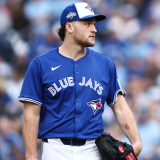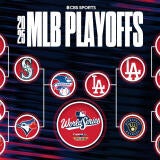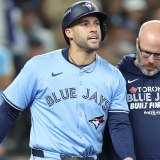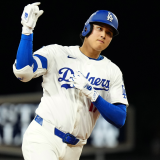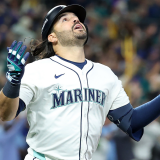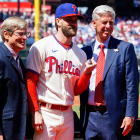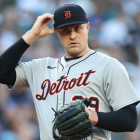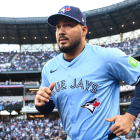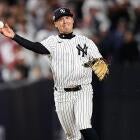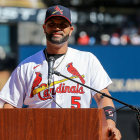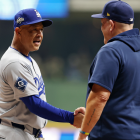
What's next for the Brewers? Baseball's best regular-season team ends season in familiar spot
The Brewers were swept by the Dodgers in the NLCS and will face familiar questions this winter
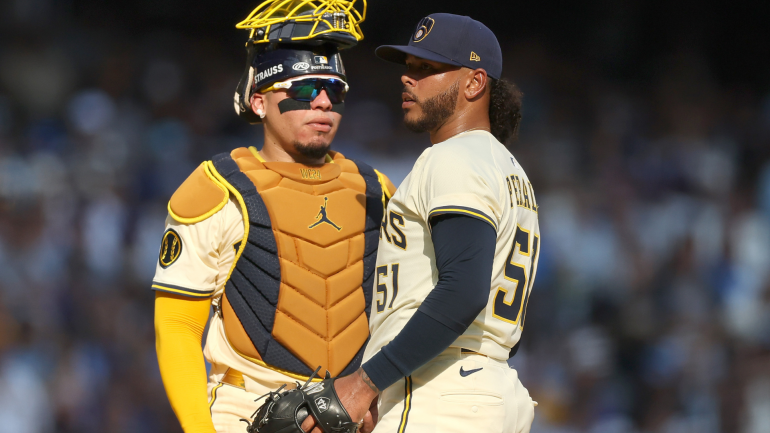
A dream season for the Milwaukee Brewers is over. After winning a franchise record 97 games during the regular season, the Brewers were unceremoniously swept by the Los Angeles Dodgers in the NLCS. The Brewers scored four runs in the four games and pitched with a lead for exactly one-third of an inning. Holding the Dodgers to 15 runs in four games was good work, but the offense no-showed, and the Brewers are going home.
Milwaukee's 97 wins led baseball and were the fewest by MLB's best team since the Boston Red Sox and St. Louis Cardinals tied for the league lead with 97 wins in 2013. You have to go back to 2007, when Cleveland and the Red Sox both finished with 96 wins, for the last time the league leader won fewer than 97 games. The Brewers' season can be split into three unequal parts:
| Record | Run differential | |
|---|---|---|
First 53 games | 25-28 (.472) | minus-6 |
Next 69 games | 53-16 (.768) | plus-168 |
Final 40 games | 19-21 (.475) | plus-19 |
The Brewers were the first team to win 53 times in a 69-game stretch since the Dodgers from July 5 to Sept. 20, 2022. Milwaukee stumbled a bit down the stretch, though they had baseball's best record and nine-game lead in the NL Central through 122 games, so we have to allow for the possibility (likelihood) that they took their foot off the gas. That certainly appeared to be the case given some of their apparent load management in September.
Milwaukee has the fifth-best winning percentage in baseball since 2018, a remarkable accomplishment given the market size, but the Brewers are only 11-20 in the postseason during that time. For all intents and purposes, the Brewers keep falling short in the postseason because they run into teams that operate the same way, only with more money. That's tough to overcome and it is something they will again set out to do in 2026. Here are three pressing questions facing the Brewers this offseason.
What happens with Peralta (and Woodruff)?
I can tell you this much: Milwaukee will exercise their bargain $8 million club option for 2026. What happens with ace Freddy Peralta after that is a bit more up in the air. The Brewers have a recent history of trading their top players a year before free agency (Corbin Burnes, Josh Hader, Devin Williams, etc.) and Peralta, one of the game's top starters the last five years, is at that point now. He is scheduled to become a free agent for the first time after next season.
For what it's worth, Peralta reportedly approached the Brewers about a contract extension at some point, but no deal was struck. Is that because the two sides were apart on dollars/years, or because the team is not interested in locking itself into what figures to be Peralta's decline phase? I suspect it was the former more than the latter. I'm sure the Brewers would love to make Peralta a Brewers for life, but as a small-market team, they have to be smart with their money.
Milwaukee's M.O. is to trade its best players a year before free agency for cheap young players who keep the perpetual motion machine moving, and there is no reason to think Peralta will be an exception. That $8 million salary is so cheap. He's worth three times that on the open market. The one-year term figures to limit Peralta's trade market to contenders only, but there will be no shortage of interested teams if the Brewers do indeed make him available.
There is also the case of Brandon Woodruff. Milwaukee's longest-tenured player returned from shoulder surgery this season and made 12 starts with a 3.20 ERA before a lat strain ended his season in September. His contract includes a $20 million mutual option with a $10 million buyout. Mutual options are usually pointless. They're a way to move money to next year's payroll (via a buyout) more than they are a way for the team and player to stay together for another year.
With Woodruff, I do wonder if this is one of the ultra-rare cases where both sides will pick up their end of the mutual option. The buyout makes it a $10 million decision for Woodruff. Can he get that as a free agent? Yeah, maybe, though he would open himself up to a pre-signing physical a year after major shoulder surgery and a few weeks after a lat strain. There's risk there. The Brewers have to pay Woodruff $10 million no matter what. Keeping him for another $10 million is a good outcome for them.
The Brewers used an opener four times in nine postseason games, which is not automatically a bad thing -- Milwaukee's offense let them down in the NLCS, not pitching -- though it does speak to a lack of innings and a lack of trustworthy three-times-through-the-lineup starters. This is the team's 2026 rotation depth chart without Peralta and Woodruff:
- RHP Jacob Misiorowski
- RHP Quinn Priester
- RHP Chad Patrick
- LHP Robert Gasser
- RHP Tobias Myers
- RHP Logan Henderson (elbow inflammation ended his season in August)
- RHP Carlos Rodriguez
- RHP Coleman Crow (flexor strain ended his season in July)
Lefty DL Hall never threw more than 3 ⅔ innings or 56 pitches in a game this season. He's had several injuries the last two years (lat, knee, oblique) and it seems like his days as a starter may be over. If they're not, great. We could slot Hall into that depth chart somewhere in that case. Otherwise that's solid rotation depth with upside (Misiorowski in particular), though it is a collection of guys more than capital-G Guys. Guys who can get you through 162 games worth of innings more than guys who start in October.
As good as they were this season, the Brewers still needed 24 starts from Jose Quintana plus a handful more from Tyler Alexander, Aaron Civale, Nestor Cortes, Elvin Rodriguez, and others. A Peralta trade is a distinct possibility, and it will remove the team's best starter and most reliable source of innings. Even if the Brewers do bring Woodruff back, there's room to add to the rotation. At least a Quintana type who soaks up innings and helps get them to the finish line of the regular season.
How do they add more power to the lineup?
Collectively, we make too much of the postseason, and I'm including myself in that "we." We read too much into 3-7 game series. The postseason is good team vs. good team, so a good team has to lose, and when they do lose, it can often be ugly, as the NLCS was for the Brewers. Sometimes you just get beat though. Not every postseason defeat happens because a team's weakness gets exploited or because they lacked some intangible quality. Sometimes you just lose.
In Milwaukee's case, it was hard not to notice that the team that hit only 166 home runs during the regular season, ninth fewest in baseball and second fewest by a postseason team (the San Diego Padres hit 152), had a hard time scoring runs in the NLCS. Part of that is the Dodgers' pitching, absolutely, but is it really a surprise that a Brewers team that ranked among the league's worst in various batted ball metrics had a hard time against top tier pitching?
| Brewers | MLB rank | MLB average | |
|---|---|---|---|
Average exit velocity | 88.6 mph | 28th | 89.4 mph |
Barrel rate (what's this?) | 6.7% | 29th | 8.6% |
Hard-hit rate | 39.2% | 25th | 40.9% |
The Brewers scored 806 runs this year, third most in baseball behind the New York Yankees (849) and Dodgers (825). The low-power offense worked for them, largely because they were baseball's best team with runners in scoring position. Power and home runs are an important piece of the pie though. It's hard to beat an ace-caliber pitcher or a lockdown bullpen by stringing together hits and walks. Look at the league-wide numbers since the 12-team postseason field was implemented in 2022:
| Runs per game | Home runs per game | |
|---|---|---|
Regular season | 4.45 | 1.16 |
Postseason | 4.05 | 1.21 |
Run scoring goes down and home runs go up in the postseason. The Dodgers hit the second most home runs during the regular season and they're in the World Series, where they'll play either the Seattle Mariners (third most homers) or the Toronto Blue Jays (11th most). The 2024 World Series featured two of the top three teams in homers. The No. 3 team in homers won the 2023 World Series. The 2022 World Series was two of the top six teams in homers. On and one we could go.
I understand the Brewers have a style of play that works (very) well for them, but I don't think it's outlandish to say they would benefit from more power. Adding it is doable. It will just take some creativity because they have payroll limitations that will prevent them from winning a free-agent bidding war for, say, Kyle Schwarber. A full year of Andrew Vaughn, William Contreras having a healthy finger, and Jackson Chourio leveling up will help. There's room to add more thump around them though.
Milwaukee's top eight and 12 of their top 13 players in plate appearances this season are under contract or team control in 2026. They can return largely the same offense next season and that's not a bad thing given this year's success. It just means that, if they do make an effort to add power, it will require some difficult decisions. Someone will have to get traded to make room, lose at-bats, etc. The lack of power is not a fatal flaw even though it looked like one in the NLCS, but it is a flaw that can be addressed.
How do they get over the hump?
In a way, the Brewers did get over the hump this year. Their NLDS win over the rival Chicago Cubs was their first postseason series win since 2018. Five postseason trips in six years from 2019-24 brought five quick exits. That's not the hump I'm talking about here though. Win as much as the Brewers have the last few years, and you should start focusing on the World Series, especially when you've never won one. Successful regular seasons count for only so much, and they can get stale after a while when they come with swift postseason defeats year after year.
The answer to the "how do they get over the hump" question could be as simple as sticking with what works, and hoping things break your way one of these years. It's an unsatisfying answer but it might be the correct answer. Clearly, the Brewers are doing a lot right. They contend every season despite running very small payrolls, and that's not easy to do. There's room to add some power here, and maybe more impact pitching, though that applies to almost every team. The Brewers are maybe 95% of the way to a World Series title. That last 5% is the hardest to figure out, and sometimes it's not even in your control.


